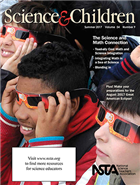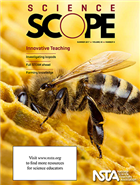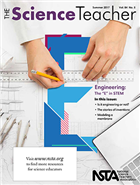Ideas and inspiration from NSTA’s July 2017 K-12 journals
By Mary Bigelow
Posted on 2017-07-16
Get ready for the total eclipse visible in parts of the US:
 Science & Children – The Science and Math Connection
Science & Children – The Science and Math Connection
Editor’s Note: The “Fundamental Tools” of Science: As they [students] investigate, we can move them beyond play by emphasizing the use of mathematics to develop scientific understanding, make predictions, record observations, create models, communicate information, and defend arguments through data.
- Many of the lessons this month incorporate data collection, graphing, and simple statistical analysis. The lessons described in the articles include connections with the NGSS.
- Toad-ally Cool Math and Science Integration describes a summer program in which students do field studies of frogs and toads. The photos show these girls in action.
- With the 5E lesson described in Bubble Babies, students investigate (using experimental design and data collection) the connection between parental care and survival rate in animals.
- Gaining Traction integrates a variety of strategies (including basic statistics) in a study of beetle behavior.
- Integrating Math in a Sea of Science is a variation of the lesson on birds’ beaks. Students study the relationship between the structure of a fish’s mouth and the type of food it eats using data they collect.
- Blending In uses colorful candies to simulate how living things that blend in with their surroundings have a higher survival rate.
- In The Early Years: Taking Math Outside, students collect objects to connect nature with skills such as classifying, sorting, counting, and comparing.
- Teaching Through Trade Books: Becoming a Citizen Scientist has two 5E lessons (K-2, 3-5) that illustrate the data collecting aspect of citizen science projects.
- Perhaps some students would enjoy describing their data as a poem — The Poetry of Science: The Math of Science.
These monthly columns continue to provide background knowledge and useful classroom ideas:
- Science 101: Q: How Do Self-Driving Cars Work?
- Methods and Strategies: Ask the Right Question
- Engineering Encounters: The Internet of Things for Kids
For more on the content that provides a context for projects and strategies described in this issue, see the SciLinks topics Adaptations, Amphibians, Animal Camouflage, Animal Reproduction, Bats, Classification, Ecosystems, Forces and Motion, Fishes, Friction, Insects, Math and Science, Plant Growth
Continue for Science Scope and The Science Teacher
 Science Scope – Inventive Teaching
Science Scope – Inventive Teaching
From the Editor’s Desk: Innovative Teaching = Learning: Innovative teachers are risk takers who are willing to accept failure. They model for others how to turn the traditional teaching model into one in which they facilitate learning by tapping into their students’ curiosity and capturing their imagination. They teach in every possible venue, often reaching out to partners with resources both within and outside their geographical area.
Articles in this issue that describe lessons include a helpful sidebar (“At a Glance”) documenting the big idea, essential pre-knowledge, time, and cost. The lessons also include connections with the NGSS.
- Moving Beyond STEAM describes how integrating the arts with traditional STEM topics adds another level of student engagement to a study of ecosystems.
- For many teachers, Unit Planning Using the Crosscutting Concepts is a new challenge. This article provides an example of the process.
- Exploring Terrestrial Isopods: How Terrestrial Isopods’ Behavior Can Influence Survival and Reproduction uses arthropods that are easily available to help students connect these concepts.
- NGSS on the farm? Incorporating a Farm Into Our Science Curriculum: An Innovative Twist shows middle school students connecting science with raising chickens and bees.
- Take your classroom word wall to the next level with Teacher’s Toolkit: Interactive word walls: Visual Scaffolds That Transform Vocabulary Instruction. The terms in Scope on the Skies: Vocabulary of the Skies could be a start.
- Integrating Technology: Innovative Youth: An Engineering and Literacy Integrated Approach includes innovative strategies to incorporate reading and science/engineering.
- Citizen Science: Summer Night Sky Citizen Science With Globe at Night describes a nighttime project collecting data to raise awareness of light pollution.
- Get students moving to improve their learning. Science for All: Kinesthetic Learning in Science has examples of tapping into students’ energy.
- Teacher to Teacher: Transitioning to Three-Dimensional Learning With Evidence Statements includes an authentic context for incorporating NGSS evidence statements.
These monthly columns continue to provide background knowledge and classroom ideas:
- Disequilibrium: How Heat Affects the Density of Water
- Listserv Roundup: Four Effective Ways to Improve Laboratory Management
For more on the content that provides a context for projects and strategies described in this issue, see the SciLinks topics Arthropods, Astronomy, Coastal Changes, Constellations, Density, Electric Circuits, Honeybees, Laboratory Safety, Populations/Communities/Ecosystems, Safety in the Science Classroom, Water Cycle, Water Erosion
Continue for The Science Teacher
 The Science Teacher – Engineering: The “E” in STEM
The Science Teacher – Engineering: The “E” in STEM
Editor’s Corner: Engineering for the Future: Engineering is the “E” that can integrate the other STEM subjects (science, technology, and mathematics). It encourages creative problem-solving and critical thinking while developing technological literacy.
The lessons described in the articles include connections with the NGSS.
- Is It Engineering or Not? has several questions and examples to change traditional activities into engineering tasks.
- Modeling a Membrane describes how students designed and created a model of a plasma membrane using readily available materials.
- Consider these Myths About the Nature of Technology and Engineering and how to deal with these misconceptions in the classroom.
- The Stories of Inventions, a four-phase PBL unit, integrates inventions into a social context.
- Troubleshooting Portfolios are documentation of student design work and an example of formative evaluation.
- Focus on Physics: Sailing Into the Wind: A Vector Explanation uses vectors to show how boats are designed and engineered to sail with and against the wind.
These monthly columns continue to provide background knowledge and classroom ideas:
- Career of the Month: Civil Engineer
- Health Wise: Getting Their Names Right
- Science 2.0: Align Your Curriculum With the ISTE Standards
- Right to the Source: View From the Top
For more on the content that provides a context for projects and strategies described in this issue, see the SciLinks topics Active Transport, Biomedical Engineer, Inventors, Cell Membrane, Diffusion, Engineer, Vectors, Winds
Disclaimer: The views expressed in this blog post are those of the author(s) and do not necessarily reflect the official position of the National Science Teaching Association (NSTA).


